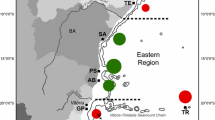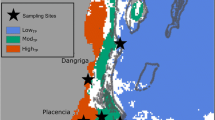Abstract
Symbioses between dinoflagellates in the genus Symbiodinium (commonly referred to as zooxanthellae) and scleractinian corals are an essential feature for the maintenance of coral reefs. The fine-scale diversity and population structure of the zooxanthellae inhabiting the coral Pocillopora meandrina, a major reef building species in Polynesia, was examined. We used two polymorphic microsatellites to study seven populations from the South Pacific, whose host structuring has been previously investigated. The symbionts of P. meandrina showed high levels of diversity, with more than one zooxanthella genotype being identified in most of the host individuals. Genetic differentiation between symbiont populations was detected at a large scale (2,000 km) between the Tonga and the Society Archipelagos. Within the Society Archipelago, the two most remote populations (Tahiti and Bora-Bora; 200 km apart) were only weakly differentiated from each other. Statistical tests demonstrated that the symbiont genetic structure was not correlated with that of its host, suggesting that dispersal of the symbionts, whether they are transported within a host larva or free in the water, depends mainly on distance and water currents. In addition, the data suggests that hosts may acquire new symbionts after maternal transmission, possibly following a disturbance event. Lastly, the weak differentiation between symbiont populations of P. verrucosa and P. meandrina, both from Moorea, indicated that there was some host-symbiont fine-scale specificity detectable at the genetic resolution offered by microsatellites.


Similar content being viewed by others
References
Adams RI, Brown KM, Hamilton MB (2004) The impact of microsatellite electromorph size homoplasy on multilocus population estimates in a tropical tree (Corythopora alta) and an anadromous fish (Morone saxatilis). Mol Ecol 13:2579–2588
Baillie BK, Belda-Baillie CA, Maruyama T, . (2000) Conspecificity and indo-pacific distribution of Symbiodinium genotypes (Dinophycea) from giant clams. J Phycol 36:1153–1161
Baker A (2003) Flexibility and specificity in coral-algal symbiosis: Diversity, ecology and biogeography of Symbiodinium. Annu Rev Ecol Evol Syst 34:661–689
Banaszak AT, Trench RK (1995) Effects of ultraviolet (UV) radiation on marine microalgal-invertebrate symbioses.I. Response of the algal symbionts in culture and in hospite. J Exp Mar Biol Ecol 194:213–232
Bhagooli R, Hidaka M (2004) Release of zooxanthellae with intact phtosynthetic activity by the coral Galaxea fascicularis in response to high temperature stress. Mar Biol 145:329–337
Brown BE (1997) Coral bleaching: causes and consequences. Coral Reefs 16(Suppl):S129–S138
Brown BE, Dunne RP, Goodson MS, Douglas AE (2000) Bleaching patterns in reef corals. Nature 404:142–143
Brown BE, Dunne RP, Goodson MS, Douglas AE (2002) Experience shapes the susceptibility of a reef coral to bleaching. Coral Reefs 21:119–126
Coffroth MA, Santos SR (2005) Genetic diversity of symbiotic dinoflagellates in the genus Symbiodinium. Protist 156(1):19–34
Coffroth MA, Santos SR, Goulet TL (2001) Early ontogenetic expression of specificity in a cnidarian-algal symbiosis. Mar Ecol Prog Ser 222:85–96
Ellegren H (2004) Microsatellites: simple sequences with complex evolution. Genetics 5: 435–445
Fabricius KE, Mieog JC, Colin PL, Idip D, van Oppen MJ (2004) Identity and diversity of coral endosymbionts (zooxanthellae) from three Palauan reefs with contrasting bleaching, temperature and shading histories. Mol Ecol 13:2445–2458
Fukami H, Budd AF, Levitan JJ, Kernasach R, Knowlton N (2004) Geographic differences in species boundaries among members of the Montastraea annularis complex based on molecular and morphological species. Evolution 58:324–337
Gattuso JP, Allemand D, Frankignoulle M (1999) Photosynthesis and calcification at cellular, organismal and community levels in coral reefs: a review on interactions and control by carbonate chemistry. Am Zool 39:160–183
Glynn PW (1993) Coral reef bleaching: ecological perspectives. Coral Reefs 12:1–17
Glynn PW, Gassman NJ, Eakin CM, Cortes J, Smith DB, Guzman HM (1991) Reef coral reproduction in the eastern Pacific: Costa Rica, Panama and Galapagos Islands (Ecuador).I Pocilloporidae. Mar Biol 109:355–368
Goulet TL, Coffroth MA (2003) Genetic composition of zooxanthellae between and within colonies of the octocoral Plexaura kuna, based on small subunit rDNA and multilocus DNA fingerprinting. Mar Biol 142:233–239
Harii S, Kayanne H, Takigawa H, Hayashibara T, Yamamoto M (2002) Larval survivorship, competency periods and settlement of two brooding corals, Heliopora coerulea and Pocillopora damicornis. Mar Biol 141:39–46
Hirose M, Kinzie III RA, Hidaka M (2000) Early development of zooxanthella-containing eggs of the corals Pocillopora verrucosa and P.eydouxi with special reference to the distribution of zooxanthellae. Biol Bull 199:68–75
Hoegh-Guldberg O, Salvat B (1995) Periodic mass-bleaching and elevated sea temperatures: bleaching of outer reef slope communities in Moorea, French Polynesia. Mar Ecol Prog Ser 121:181–190
Hunter CL, Morden CW, Smith CM (1997) The utility of ITS sequences in assessing relationships among zooxanthellae and corals. Proc 8th Int Coral Reef Sym 2:1599–1602
Korbecka G, Vrieling K, Squirrell J, Hale ML, Wolff K (2003) Characterization of six microsatellite loci in Echium vulgare (Boraginaceae). Mol Ecol Notes 3:274–276
Kruger A, Schleyer MH (1998) Sexual reproduction in the coral Pocillopora verrucosa (Cnidaria: Scleractinia) in KwaZulu-Natal, South Africa. Mar Biol 132:703–710
Kumar S, Tamura K, Jakobsen IB, Nei M (2001) MEGA2: Molecular Evolutionary Genetics Analysis software. Bioinfomatics 12:1244–1245
LaJeunesse TC (2001) Investigating the biodiversity, ecology, and phylogeny of endosymbiotic dinoflagellates in the genus Symbiodinium using the ITS region: In search of a “species” level marker. J Phycol 37:866–880
LaJeunesse TC (2002) Diversity and community structure of symbiotic dinoflagellates from Carribean coral reefs. Mar Biol 141:387–400
LaJeunesse TC, Bhagooli R, Hidaka M, deVantier L, Done T, Schmidt GW, Fitt WK, Hoegh GO (2004a) Closely related Symbiodinium spp. differ in relative dominance in coral reef host communities across environmental, latitudinal and biogeographic gradients. Mar Ecol Prog Ser 284:147–161
LaJeunesse TC, Loh W, van Woesik R, Hoegh GO, Schmidt GW, Fitt WK (2003) Low symbiont diversity in southern Great Barrier Reef corals, relative to those of the Carribean. Limnol Oceano 48:2046–2054
LaJeunesse TC, Thornhill DJ, Cox EF, Stanton FG, Fitt WK, Schmidt GW (2004b) High genetic diversity and host specificity observed among symbiotic dinoflagellates in reef coral communities from Hawaii. Coral reefs 23: 596–603
LaJeunesse TC, Trench RK (2000) Biogeography of two species of Symbiodinium (Freudenthal) inhabiting the intertidal sea anemone Anthopleura elegantissima (Brandt). Biol Bull 199:126–134
Legendre P, Fortin M-J (1989) Spatial pattern and ecological analysis. Vegetation 80:107–138
Lewis CL, Coffroth MA (2004) The acquisition of exogenous algal symbionts by an octocoral after bleaching. Science 304:1490–1492
Little AF, Van Oppen MJ, Willis BL (2004) Flexibility in algal endosymbioses shapes growth in reef corals. Science 304:1492–1494
Magalon H, Adjeroud M, Veuille M (2005) Patterns of genetic variation do not correlate with geographical distance in the reef building coral Pocillopora meandrina in the South Pacific. Mol Ecol 14:1861–1868
Magalon H, Samadi S, Richard M, Adjeroud M, Veuille M (2004) Development of coral and zooxanthella-specific microsatellites in three species of Pocillopora (Cnidaria, Scleractinia) from French Polynesia. Mol Ecol Notes 4:206–208
Maruyama T, Heslinga GA (1997) Fecal discharge of zooxanthellae in the giant clam Tridacna derasa, with reference to their in situ growth rate. Mar Biol 127:473–477
Mumby PJ, Chisholm JRM, Edwards AJ, Andrefouet S, Jaubert J (2001) Cloudy weather may have saved Society Island reef corals during the 1998 ENSO event. Mar Ecol Prog Ser 222:209–216
Nei M (1978) Estimation of average heterozygosity and genetic distance for small number of individuals. Genetics 89:583–590
Perez SF, Cook CB, Brooks WR (2001) The role of symbiotic dinoflagellates in the temperature-induced bleaching response of the subtropical sea anemone Aiptasia pallida. J Exp Mar Biol Ecol 256:1–14
Pochon X, Pawlowski J, Zaninetti L, Rowan R (2001) High genetic diversity and relative specificity among Symbiodinium-like endosymbiotic dinoflagellates in soritid foraminiferans. Mar Biol 139:1069–1078
Rice WR (1989) Analyzing tables of statistical tests. Evolution 43:223–225
Rodriguez-Lanetty M, Krupp DA, Weis VM (2004) Distinct ITS types of Symbiodinium in clade C correlate with cnidarian/dinoflagellate specificity during onset of symbiosis. Mar Ecol Prog Ser 275:97–102
Rougerie F, Wauthy B (1986) L’Ocean qui nous entoure p73–78. Encyclopédie de la POlynésie vol I: les îles océaniques, Multipress. Papeete, Polynésie Française
Santos SR, Coffroth MA (2003) Molecular genetic evidence that dinoflagellates belonging to the genus Symbiodinium Freudenthal are haploid. Biol Bull 204:10–20
Santos SR, Gutiérrez-Rodriguez C, Lasker HR, Coffroth MA (2003) Symbiodinium sp. associations in the gorgonian Pseudopterogorgia elisabethae in the Bahamas high levels of genetic variability and population structure in symbiotic dinoflagellates. Mar Biol 143:111–120
Santos SR, Shearer TL, Hannes AR, Coffroth MA (2004) Fine-scale diversity and specificity in the most prevalent lineage of symbiotic dinoflagellates (Symbiodinium, Dinophyceae) of the Carribean. Mol Ecol 13:459–469
Santos SR, Taylor DJ, Coffroth MA (2001) Genetic comparisons of freshly isolated versus cultured symbiotic dinoflagellates: Implications for extrapolating to the intact symbiosis. J Phycol 37:900–912
Savage AM, Goodson MS, Visram S, Trapido-Rosenthal H, Wiedenmann J, Douglas AE (2002a) Latitudinal diversity of symbiotic algae at the latitudinal margins of their distribution: dinoflagellates of the genus Symbiodinium in corals and sea anemones. Mar Ecol Prog Ser 244:17–26
Savage AM, Trapido-Rosenthal H, Douglas AE (2002b) On the functional significance of molecular variation in Symbiodinium, the symbiotic algae of Cnidaria: photosynthetic response to irradiance. Mar Ecol Prog Ser 244:27–37
Schneider S, Roessli D, Excoffier L (2000) Arlequin ver. 2.000: A software for population genetics data analysis. Genetics and Biometry Laboratory, University of Geneva, Switzerland
Schwarz JA, Weis VM, Potts DC (2002) Feeding behavior and acquisition of zooxanthellae by planula larvae of the sea anemone Anthopleura elegantissima. Mar Biol 140:471–478
Sier CJS, Olive PJW (1994) Reproduction and reproductive variability in the coral Pocillopora verrucosa from the Republic of Maldives. Mar Biol 118:713–722
Slatkin M (1993) Isolation by distance in equilibrium and non-equilibrium populations. Evolution 47:264–279
Smouse PE, Long JC, Sokal RR (1986) Multiple regression and correlation extensions of the Mantel test of matrix correspondence. Syst Zool 35:627–632
Tchernov D, Gorbunov MY, de Vargas C, Narayan Yadav S, Milligan AJ, Häggblom M, Falkowski PG (2004) Membrane lipids of symbiotic algae are diagnostic of sentivity to thermal bleaching in corals. PNAS 101(37):13531–13535
Trench RK (1993) Microalgal-invertebrate symbioses: a review. Endocyt Cell Res 9:135–175
Van Oppen MJ, Koolmes EM, Veron JEN (2004) Patterns of evolution in the scleractinian coral genus Montipora (Acroporidae). Mar Biol 144:9–18
van Oppen MJ, McDonald BJ, Willis B, Miller DJ (2001a) The evolutionary history of the coral genus Acropora (Scleractinia, Cnidaria) based on a mitochondrial and a nuclear marker: reticulation, incomplete lineage sorting, or morphological convergence? Mol Biol Evol 18:1315–1329
van Oppen MJ, Palstra FP, Piquet AM, Miller DJ (2001b) Patterns of coral-dinoflagellate associations in Acropora: significance of local availability and physiology of Symbiodinium strains and host- symbiont selectivity. Proc R Soc Lond B 268:1759–1767
Van Oppen MJ, Willis BL, Vugt HW, Miller DJ (2000) Examination of species boundaries in the Acropora cervicornis group (Scleractinia, cnidaria) using nuclear DNA sequence analyses. Mol Ecol 9:1363–1373
Viard F, Franck P, Dubois M-P, Estoup A, Jarne P (1998) Variation of microsatellite size homoplasy across electromorphs, loci and populations in three invertebrates species. J Mol Evol 47:42–51
Vollmer SV, Palumbi SR (2002) Hybridization and the evolution of reef coral diversity. Science 296: 2023–2025
Weir B, Cockerham C (1984) Estimating F-statistics for the analysis of population structure. Evolution 38:1358–1370
Weis VM, Reynolds WS, deBoer MD, Krupp DA (2001) Host-symbiont specificity during onset of the symbiosis between the dinoflagellates Symbiodinium spp. and planula larvae of the scleractinian coral Fungia scutaria. Coral Reefs 20:301–308
Acknowledgements
We thank Scott R. Santos for helpful advice, valuable comments and corrections, and Todd C. LaJeunesse for his help in zooxanthellae identification and relevant comments. We also thank the three anonymous reviewers for their comments that improved the manuscript. We thank the French Ministère de l’Outremer. This research was supported by a grant from the EPHE PPF network to Michel Veuille, by a grant from the TotalFinaElf Foundation to Mehdi Adjeroud, and by a Docteur-Ingénieur fellowship from the CNRS to Hélène Magalon.
Author information
Authors and Affiliations
Corresponding author
Additional information
Communicated by O. Kinne, Oldendorf/Luhe
Rights and permissions
About this article
Cite this article
Magalon, H., Baudry, E., Husté, A. et al. High genetic diversity of the symbiotic dinoflagellates in the coral Pocillopora meandrina from the South Pacific. Marine Biology 148, 913–922 (2006). https://doi.org/10.1007/s00227-005-0133-z
Received:
Accepted:
Published:
Issue Date:
DOI: https://doi.org/10.1007/s00227-005-0133-z




